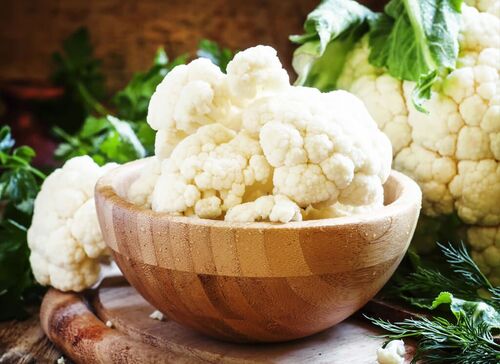Growing Cauliflower

The cauliflower is not the easiest of the brassica family to grow but a large white cauliflower with tight white curds is a thing of beauty and producing one a source of much satisfaction. Variety is important, especially for beginners with a very healthy and well fed soil essential.
Differend kind of cauliflower seeds >
Sowing cauliflower
You can sow Cauliflower in late March, early May and early June for a long cropping season. We highly recommend sowing your cauliflower in modular trays. You can sow directly into the soil but you'll have better success with this method for the following reasons:
- Excellent crop establishment
- Uniform plant development
- Quick transplanting with minimum root disturbance
- Gives the plant a head start against weather and garden pests and diseases.
Planting out the cauliflower
Plant cauliflower in rows with each plant spaced 18 inches apart. Rows should be 30 inches apart. Improve your native soil by mixing in several inches of compost or other rich organic matter.
Companion planting
Just like any other vegetable, cauliflowers have good and 'bad' neighbours. By this we mean that it is not always wise to put certain crops next to each other.
Good neighbors of the cauliflower
Bad neighbors of the cauliflower
Soil
Like most vegetables, cauliflower needs at least 6 hours of full sun each day; more is better. It also needs fertile, well-drained, moist soil with plenty of rich organic matter. The soil pH should be between 6.5 and 6.8 for optimum growth and to discourage clubroot disease. Organic mulch will help keep the soil cool and moist and will suppress weeds. Apply 1 to 1.5 inches of water per week if rain falls short.
Protection
Cauliflower heads that are exposed to sunlight can turn greenish-brown, and be a little bitter. For cauliflower heads to be mild tasting and pure white, the developing flower bud has to be shaded from the sun. Once the white head is 2 to 3 inches (5 to 7.5 cm.) across, tie the leaves of the plant together so they shelter it.
Snails and slugs
Many gritty substances make effective snail repellents. Gritty substances will cut the body of the snail, which will lead to it being injured. Crushed eggshells, cocoa shells, sand or diatomaceous earth sprinkled around plants that the garden snails seem to prefer will deter and eventually kill these pests.
When harvesting Cauliflower?
Harvest when the head grows to 6–8 in (15–20 cm) and is white and firm. Healthy cauliflower grows 1 large head in the center of the plant. When the head of your cauliflower is compact and sizable, it is are ready for harvest. Avoid harvesting them too early before the head is completely white. Also, avoid waiting to harvest until the head of the cauliflower spreads out. Cut the heads off the plant with a large knife. Be sure to leave some of the leaves around the head to keep it protected.
Varieties of Cauliflower
There are hundreds of varieties of cauliflower that come in various colors. The most common type of cauliflower is the white variety with its distinct ivory-white head and dark green leaves. There are other colored cauliflower varieties that are purple, yellow, orange, and green.
In our garden seeds webshop we have the following types of cauliflower seeds :



